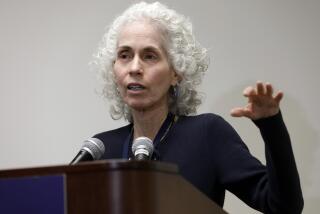Drawing a Health-Care Line
- Share via
In a perfect world, hospitals would not recognize borders any more than illnesses do. But in this world, more than 2 million Los Angeles County residents lack medical insurance and the cost of treating them has left the county’s health-care system teetering on the edge of collapse. So the Board of Supervisors on Tuesday ordered county hospitals to stop providing free, nonemergency care to people who live beyond the county limits.
Voters who recently approved a property tax increase to bail out the county’s trauma centers and emergency rooms are probably dumbfounded that the cash-strapped county ever gave nonresidents a free ride -- outside of the ERs, which are required by federal law to treat everyone who needs care. Some see in the old open-door policy a cynical ploy to maintain a bloated bureaucracy and protect union jobs. A kinder explanation is that refusing to turn people away was a moral choice. Now it is an unaffordable one, especially when out-of-county residents show up with maps to County-USC Medical Center in their hands.
San Diego and Orange counties meet their state mandate to care for the poor by paying private university or nonprofit hospitals and clinics to do so and by restricting whose care and which treatments will be reimbursed. San Diego County pays for only the indigent, not the working poor, and excludes noncounty residents and undocumented immigrants. Orange County pays only for treatment to prevent death, disability or serious harm.
The burden to pick up those who don’t make the cut falls on charities, private hospitals -- and L.A. County. Officially, they make up about 4% of L.A. hospital admissions, but the actual percentage is unknown: The only patients considered out-of-county are those who readily admit that.
Patient-dumping by neighboring counties is not the reason L.A. County is in a health-care crisis. The root cause is the millions of Californians -- of Americans -- without health insurance. L.A. County barely has the money or capacity to care for its own. And if the county-run system collapses, even people who don’t often use it will be hard-pressed to find an emergency room that isn’t overwhelmed. They will also wonder, too late, what happened to the expertise that has helped keep infectious diseases such as SARS absent or under control in Southern California.
The county may not have the authority to force its neighbors to take back their own uninsured, but by refusing to take up the slack, it sends a message to Sacramento and Washington that this crisis demands a state and federal solution. It is not one that can be solved by shuffling poor people from one county to another.
More to Read
Sign up for Essential California
The most important California stories and recommendations in your inbox every morning.
You may occasionally receive promotional content from the Los Angeles Times.













